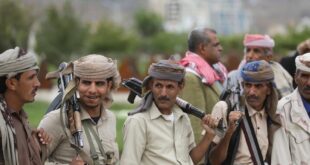TSKHINVALI, Georgia: Six months after Russia and Georgia fought a war over South Ossetia, the enclave’s capital city is still a mass of fresh scars.
Many people in Tskhinvali are shivering through the winter behind windows made of plastic sheeting. Piles of broken glass and trash – in one case, the charred turret of a Georgian tank – sit along central boulevards, as they did in August. Stray dogs, their owners long gone, nose around the streets for food.
There are reminders of the euphoria that swept this valley last summer, when Russia acknowledged South Ossetia’s 18-year separatist struggle by recognizing it as a sovereign nation. Graffiti proclaims “Ossetia thanks its defenders” and “Great Russia,” and citizens say they are extraordinarily grateful to be free of Georgian governance.
But it has been a hard winter, and reconstruction is moving slowly. The South Ossetian president, Eduard Kokoity, said the process had been delayed by price gouging and shoddy workmanship by unscrupulous contractors in the first round of reconstruction, and he promised that the pace would pick up this spring. Residents, many of whom scrounged materials and patched up their homes themselves, are beginning to wonder when the promised aid will reach them.
“We have no running water at home,” said Maria Pliyeva, 25, a reporter for 21st Century, a newspaper in Tskhinvali. “It’s not just an inconvenience. It’s embarrassing to speak about a government of a country which is seeking recognition when you have no running water.”
The halting reconstruction underlines the challenge facing South Ossetia, a rural patch of land whose prewar population was 70,000, even as Russia has elevated it into a national symbol. When Georgia began an assault on the separatist capital on Aug. 7, Russia sent columns of armor to protect its allies.
Russians saw the attack on Tskhinvali, which they call by its Ossetian name, Tskhinval, as a watershed moment, and aid pledges flooded in. Trucks bearing donations were backed up on Tskhinvali’s streets, and billboards in Moscow promised “Tskhinval, we are with you!”
But nearly two decades of bitter conflict with Georgia have left the enclave with only two factories that produce building materials. (One makes asphalt and the other the clear plastic to cover broken windows, an aide to Kokoity said.) South Ossetia can no longer count on supplies from Georgia, as residents learned when deliveries of natural gas halted for the coldest months.
Meanwhile, the narrow highway that links the enclave to Russia is plagued by avalanches and is impassable for much of the winter. Even in good weather, shipments coming from the north are vulnerable to theft and diversion. Charles King, an expert on the region, said South Ossetia long served as a “gigantic magnet for contraband” passing between Russia and Georgia, economically dependent on informal taxes levied on shipments.
“If someone is trying to send physical aid to South Ossetia, it’s very likely that it’s going to go missing,” said King, author of “The Ghost of Freedom: A History of the Caucasus.”
Whatever the reasons, progress has been slow. A report released in December by Russia’s federal auditing agency found that of about $55 million in priority aid pledged by Russia, only about $15 million had been delivered and only $1.4 million spent. It also found that of 111 structures scheduled for renovation by the end of 2008, eight had been completed and 38 had not yet been touched.
The same month, a former South Ossetian defense minister who is a political rival of Kokoity’s, Anatoly Barankevich, told the Russian daily newspaper Kommersant that local officials had diverted 3,200 tons of cement and nearly 19,000 square meters, or 200,000 square feet, of glass intended to repair citizens’ homes. Kokoity denied the report, telling the newspaper that “certain pro-Georgian forces are trying to discredit South Ossetia in the eyes of Russia and Russians.”
The delays have become a headache for Kokoity, who was met with roars of adulation last summer when Moscow formally recognized his government. Meeting with foreign journalists in Tskhinvali, he said the process had been slowed by dishonest subcontractors chosen after the war by Russia’s Ministry of Regional Development. Authorities say they have spent only $42 million of the roughly $280 million in pledged Russian money and that the pace will speed up now that a more effective system of financial controls is in place.
“We are responsible to every citizen of the Russian Federation to ensure that this money is used in a full manner,” Kokoity said. “Better let it stay in the Ministry of Finance than let sleazy people get their hands on it.”
 Eurasia Press & News
Eurasia Press & News
